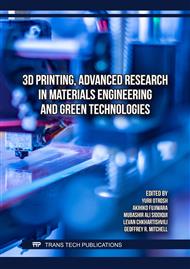[1]
A. A. Ayalew, A critical review on clay-based nanocomposite particles for application of wastewater treatment. Water Science and Technology. 85(10) (2022) 3002–3022.
DOI: 10.2166/wst.2022.150
Google Scholar
[2]
N. Narayanan, S. Gupta, V. T. Gajbhiye, Decontamination of pesticide industrial effluent by adsorption–coagulation–flocculation process using biopolymer-nanoorganoclay composite. International Journal of Environmental Science and Technology. 17(12) (2020) 4775–4786.
DOI: 10.1007/s13762-020-02785-y
Google Scholar
[3]
D.W. Skaf, V.L. Punzi, J.T. Rolle, K.A. Kleinberg, Removal of micron-sized microplastic particles from simulated drinking water via alum coagulation. Chemical Engineering Journal. 386 (2020) 123807.
DOI: 10.1016/j.cej.2019.123807
Google Scholar
[4]
B. Verma, C. Balomajumder, Hexavalent chromium reduction from real electroplating wastewater by chemical precipitation. Bulletin of the Chemical Society of Ethiopia. 34(1) (2020) 67–74.
DOI: 10.4314/bcse.v34i1.6
Google Scholar
[5]
A. Khazaie, M. Mazarji, B. Samali, D. Osborne, T. Minkina, S. Sushkova, S. Mandzhieva, A. Soldatov, A Review on Coagulation/Flocculation in Dewatering of Coal Slurry. Water. 14(6) (2022) 918.
DOI: 10.3390/w14060918
Google Scholar
[6]
C.S. Lee, J. Robinson, M. F. Chong, A review on application of flocculants in wastewater treatment. Process Saf. Environ. Prot. 92 (2014) 489–508.
Google Scholar
[7]
B. Oyegbile, P.Ay, S. Narra, Flocculation kinetics and hydrodynamic interactions in natural and engineered flow systems: A review. Environmental Engineering Research. 21(1) (2016) 1–14.
DOI: 10.4491/eer.2015.086
Google Scholar
[8]
A. Shakeel, Z. Safar, M. Ibanez, L. van Paassen, C. Chassagne, Flocculation of Clay Suspensions by Anionic and Cationic Polyelectrolytes: A Systematic Analysis. Minerals. 10 (11) (2020) 999.
DOI: 10.3390/min10110999
Google Scholar
[9]
F. Bergaya, G. Lagaly, Handbook of Clay Science; Newnes: Amsterdam, The Netherland. 5 2013.
Google Scholar
[10]
A. Mierczynska-Vasilev, M. Kor, J. Addai-Mensah, D. A. Beattie, The influence of polymer chemistry on adsorption and flocculation of talc suspensions. Chem. Eng. J. 220 (2013) 375–38.
DOI: 10.1016/j.cej.2012.12.080
Google Scholar
[11]
A. Shkop, M. Tseitlin, O.Shestopalov, V. Raiko, A study of the flocculs strength of polydisperse coal suspensions to mechanical influences. EUREKA: Physics and Engineering. 1 (2017) 13–20.
DOI: 10.21303/2461-4262.2017.00268
Google Scholar
[12]
A. Shkop, M. Tseitlin, O. Shestopalov, V. Raiko, Study of the strength of flocculated structures of polydispersed coal suspensions. Eastern-European Journal of Enterprise Technologies. 1(10 (85)) (2017) 20–26.
DOI: 10.15587/1729-4061.2017.91031
Google Scholar
[13]
O. Shestopalov, N. Rykusova, O. Hetta, V. Ananieva, O. Chynchyk, Revealing patterns in the aggregation and deposition kinetics of the solid phase in drilling wastewater. Eastern-European journal of enterprise technologies. 1/10 (97) (2019) 50–58.
DOI: 10.15587/1729-4061.2019.157242
Google Scholar
[14]
N. Rykusova, O. Shestopalov, V. Lebedev, T. Tykhomyrova, G. Bakharievа, Identification of properties of recycled highdensity polyethylene composites when filled with waste mud solids. Eastern-European Journal of Enterprise Technologies. 2(10 (98)) (2019) 55–60.
DOI: 10.15587/1729-4061.2019.163656
Google Scholar
[15]
N. Rykusova, O. Shestopalov, L. Shchukina, L. Yashchenko, I. Stanovska, A. Muradian, V. Ocheretna, Establishing the regularities in forming the properties of ceramic wall materials containing waste from gas extraction (drilling sludge). Eastern-European Journal of Enterprise Technologies. 2(6 (104)) (2020) 21–27.
DOI: 10.15587/1729-4061.2020.200994
Google Scholar


